FACTS
your T-stat restricts and is designed to restrict water/coolant flow below the temp rating where it opens, it has little effect on the upper engine temp,
IF IT OPENS FULLY AS DESIGNED AT THE RATED TEMP.
\ its designed to allow the engine to reach and maintain the MINIMUM rated temp.

FACT
restrictors were designed to replace T-stats in applications where there was little or no need to worry about minimum temps BUT there was a valid concern that the water pumps impellers might CAVITATE (IE spin fast enought to spin loose of the water/coolant and fail too pump effectively,at high rpms without some restriction to the flow to the radiator or the t-stat might be slow to respond and the engine might overheat, if air got trapped under the T-stat,(READ STOCK CAR RACING) remember the water pump SUCKS (NEGATIVE PRESSURE) the coolant from the block and pours coolant into the top of the radiator on the GEN 1 CHEVY sbc. gen IV-VI BBC
just some info too think thru
the engines state of tune effects the heat generated, vacuum leaks tend to increase heat, octane used effects the heat, your ignition timing curve effects the heat
the type of coolant effects the rate heats transfered
the amount and type of oil effects the temp transfer rates
a larger oil filter, and larger capacity baffeled oil pan, tends to reduce temps due to exposing a larger surface area to the air flow, keeping the average oil temp in the pan lower
anything that reduces airflow thru the radiator reduces its efficiency
the water pump and T-stat both effect the rate heats transfered, high flow water pumps can help
the electric fans work off a sensor and the temp they turn on at can be modified, larger or additional electrical fans can be added
on an auto trans car,the transmission fluid adds a good deal of heat to the radiator, adding a seperate ADDITIONAL trans cooler with a seperate ellectric fan,removes a good deal of the load from the radiator
oil in the engine flowing over parts absorbs and transfers heat , having a larger baffled oil pan hanging down in the airflow under the engine helps cool the engine
headers remove heat faster than stock exhaust manifolds
aftermarket aluminum radiators can be far more efficient
the dia. of the pullies your using does effect the coolant flow
running the correct T-stat can help cooling, generally the 180F-190F is the best compromize.
if your thinking drilling a few holes in the t-stat will allow the engine to run cooler , well
that would depend on how you define HELPS COOLING, Ive always felt it helps stabilize the coolant temp swings but it does NOTHING to reduce temps the engine will reach unless the T-stat is defective, once the t-stat opens the rate heat transfer fron the coolant flow is mostly the result of outside air temps, coolant temps and the radiator fins surface area, and the rate of air flow over the fins.
drilling a couple small holes in a t-stat if done correctly tends to reduce the potential for air to be trapped in the cooling system, the t-stats function is to prevent coolant circulation untill the coolant reaches a predesigned temerature, where it opens and allows coolant to flow , untill, the temp falls below that designed temp. drilling a couple holes tends to increase the time required for the engine to reach full operational tends slightly but it also tends to reduce the temp swings between a t-stat opening and closing as it cycles , as cooler fluid covers and cools it in some conditions
https://www.flowkoolerwaterpumps.com/info/standard_reverse_rotation.html
http://www.digitalcorvettes.com/forums/ ... hp?t=81691
http://www.becool.com/
http://www.dewitts.com/pages/categoryre ... p?catID=19
http://www.kevko.net/images/1090_full.gif
http://www.kevko.net/wetsump_chevy.htm
http://www.stefs.com/products/oilpans/c ... etsump.htm
http://www.radiatorbarn.com/?source=overture
http://garage.grumpysperformance.com/index.php?threads/the-force-awakens.14249/#post-72458
engine oil needs to reach and stay at about 215F-240f to lube and clean correctly and burn off moisture
trans fluid I try to keep under 160F,surely below 180F ,
Ideally I try to keep engine coolant in the engine in the 190F-200F range but don,t get overly worried below 230F. BTW I run a 190F t-stat, temp ranges should be kept within these ranges or the wear and emmissions won,t give you the long engine and trans life and low emmission levels you expect , drop the coolant temps lower and you may gain a few hp but the wear tends to get worse as the fluids can,t opperate correctly, drop the oil temp below 211 F and acids can form in the oil (bad for bearings)

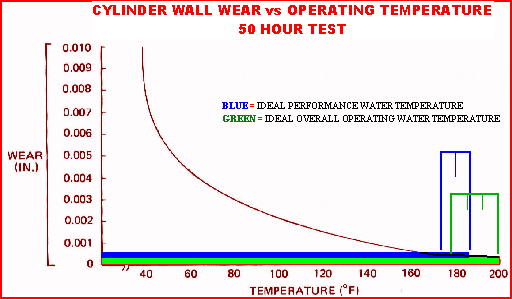
in an ideal world the coolant temp would stay in the 190F-200F range, install a 180F-or-190F t-stat and have the fans reprogramed to come on at about 185F-200F and youll see a marked stabilization of the coolant temp IF everythings functioning CORRECTLY
heres the fan control kits
185F
http://store.summitracing.com/partdetai ... SUM-890015
200F
http://store.summitracing.com/partdetai ... toview=sku
this external trans cooler
http://store.summitracing.com/partdetai ... toview=sku
personally I sellected the 190F T-stat 185F fan control , but IM seriously thinking of getting the 200F fan control simply because with my external trans cooler the engine oil temp seldom gets over 220F and it takes 215F to burn off all moisture in the oil.
on my corvette I felt the proper route was hot tranny fluid out to radiator then to the electric fan cooled trans cooler then back to the trans, simply because that maximized the temp drop to the trans AND I was not having ANY trouble cooling the engine, in fact the oil temp seldom exceeds 230F and takes a fairly long time to reach 215F.
I don,t know the trans fluid pressure but I did verify that my trans cooler was designed for transmision heat/pressure and was factory tested at 300PSI.
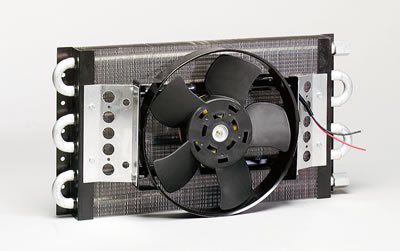
BTW if you route the other direction, IE seperate trans cooler first then to the radiator it makes for a significant reduction in coolant temp, and the fan on the seperate tranny fluid cooler runs constantly, but the engine coolant has a difficult time getting up to temp,(at least on my corvette) of reaching or allowing the oil temp in the engine to reach 215F LETS NOT GET INTO HOW I KNOW THAT :laughing:
btw some comon areas people SCREW-UP
(1)
theres TWO differant types of water pumps, most serpentine belt water pumps are REVERSE ROTATION compared to the standard SBC water pumps and of course wount work correctly if they get installed in an application where they spin in the wrong dirrection
(2)
some head gaskets have significantly smaller than standard water flow passage holes that significantly restrict coolant flow rates to the heads, youll need to verify your useing the correct gaskets
(3)
your ignition timing has a huge effect on the engine temp, verify its close to correct, on both total timing and it advances smoothly as the rpms go up.
(4)never mix the older GREEN and newer ORANGE COOLANT (ANTI-FREEZE) they CAN in rare cases form a JELL over several months and clog a radiator
(5) air flow thru the radiator is critical, make darn sure theres no crud blocking the radiator fins, CLEAN IT FREQUENTLY with soapy water and a hose it takes surprizingly little mud or grass stuck in the fins to significantly raise temps and you won,t be the first guy to have a plastic bag or paper or leaves sucked up and blocking the air flow
(6) T-stats can go deffective, Id advise useing a known brand in a 180F-190f RANGE, and type , not the cheapest crap you can find
BTW I normally drill 8-10 equally spaced 1/8" holes in the flange of the corvetts t-stat all around the perimeter this allows coolant to flow even if the t-stat locks closed and prevents air trapped under the flange, the picture below is of a semi similar mod on a differant cars T-stat, yes it takes longer to reach full temp, but Ive found no down side and it works better with this mod in my opinion
the picture below is of a semi similar mod on a differant cars T-stat, yes it takes longer to reach full temp, but Ive found no down side and it works better with this mod in my opinion
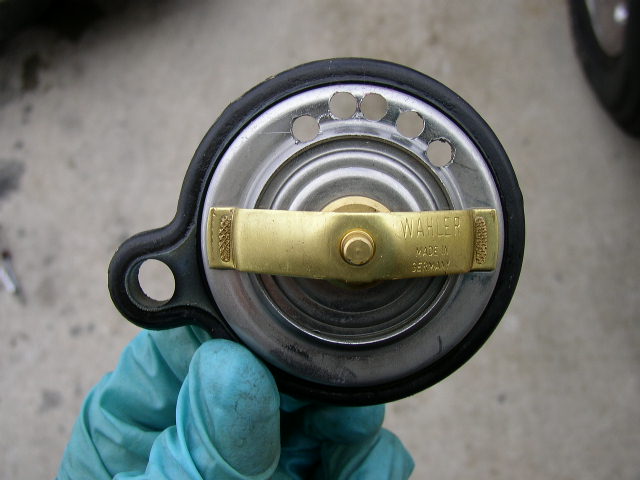
most t-stats work by by having a thermo reactive wax that starts to expand at a set temperature , then over about 10F-20F it continues to expand,and allow heated coolant to flow to the radiator, thus the t-stat will remain closed until its rated temperature range is reached and it will open wider up to its fully open position over about a 2-5 minute time frame
heres a couple chevy t-stats
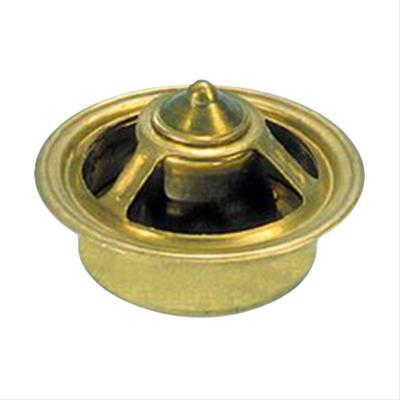
Ive seen fewer of the upper design fail to function correctly
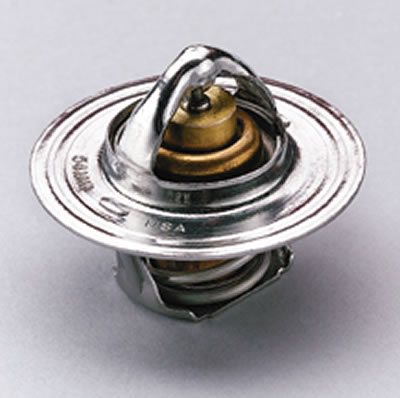
now IM sure some guys will say that defeats the T-stats purpose but it still works and theres a noticable increase in coolant flow at 190F when the t-stat opens so I feel its a no lost deal
your T-stat restricts and is designed to restrict water/coolant flow below the temp rating where it opens, it has little effect on the upper engine temp,
IF IT OPENS FULLY AS DESIGNED AT THE RATED TEMP.
\ its designed to allow the engine to reach and maintain the MINIMUM rated temp.

FACT
restrictors were designed to replace T-stats in applications where there was little or no need to worry about minimum temps BUT there was a valid concern that the water pumps impellers might CAVITATE (IE spin fast enought to spin loose of the water/coolant and fail too pump effectively,at high rpms without some restriction to the flow to the radiator or the t-stat might be slow to respond and the engine might overheat, if air got trapped under the T-stat,(READ STOCK CAR RACING) remember the water pump SUCKS (NEGATIVE PRESSURE) the coolant from the block and pours coolant into the top of the radiator on the GEN 1 CHEVY sbc. gen IV-VI BBC
just some info too think thru
the engines state of tune effects the heat generated, vacuum leaks tend to increase heat, octane used effects the heat, your ignition timing curve effects the heat
the type of coolant effects the rate heats transfered
the amount and type of oil effects the temp transfer rates
a larger oil filter, and larger capacity baffeled oil pan, tends to reduce temps due to exposing a larger surface area to the air flow, keeping the average oil temp in the pan lower
anything that reduces airflow thru the radiator reduces its efficiency
the water pump and T-stat both effect the rate heats transfered, high flow water pumps can help
the electric fans work off a sensor and the temp they turn on at can be modified, larger or additional electrical fans can be added
on an auto trans car,the transmission fluid adds a good deal of heat to the radiator, adding a seperate ADDITIONAL trans cooler with a seperate ellectric fan,removes a good deal of the load from the radiator
oil in the engine flowing over parts absorbs and transfers heat , having a larger baffled oil pan hanging down in the airflow under the engine helps cool the engine
headers remove heat faster than stock exhaust manifolds
aftermarket aluminum radiators can be far more efficient
the dia. of the pullies your using does effect the coolant flow
running the correct T-stat can help cooling, generally the 180F-190F is the best compromize.
if your thinking drilling a few holes in the t-stat will allow the engine to run cooler , well
that would depend on how you define HELPS COOLING, Ive always felt it helps stabilize the coolant temp swings but it does NOTHING to reduce temps the engine will reach unless the T-stat is defective, once the t-stat opens the rate heat transfer fron the coolant flow is mostly the result of outside air temps, coolant temps and the radiator fins surface area, and the rate of air flow over the fins.
drilling a couple small holes in a t-stat if done correctly tends to reduce the potential for air to be trapped in the cooling system, the t-stats function is to prevent coolant circulation untill the coolant reaches a predesigned temerature, where it opens and allows coolant to flow , untill, the temp falls below that designed temp. drilling a couple holes tends to increase the time required for the engine to reach full operational tends slightly but it also tends to reduce the temp swings between a t-stat opening and closing as it cycles , as cooler fluid covers and cools it in some conditions
https://www.flowkoolerwaterpumps.com/info/standard_reverse_rotation.html
http://www.digitalcorvettes.com/forums/ ... hp?t=81691
http://www.becool.com/
http://www.dewitts.com/pages/categoryre ... p?catID=19
http://www.kevko.net/images/1090_full.gif
http://www.kevko.net/wetsump_chevy.htm
http://www.stefs.com/products/oilpans/c ... etsump.htm
http://www.radiatorbarn.com/?source=overture
http://garage.grumpysperformance.com/index.php?threads/the-force-awakens.14249/#post-72458
engine oil needs to reach and stay at about 215F-240f to lube and clean correctly and burn off moisture
trans fluid I try to keep under 160F,surely below 180F ,
Ideally I try to keep engine coolant in the engine in the 190F-200F range but don,t get overly worried below 230F. BTW I run a 190F t-stat, temp ranges should be kept within these ranges or the wear and emmissions won,t give you the long engine and trans life and low emmission levels you expect , drop the coolant temps lower and you may gain a few hp but the wear tends to get worse as the fluids can,t opperate correctly, drop the oil temp below 211 F and acids can form in the oil (bad for bearings)


in an ideal world the coolant temp would stay in the 190F-200F range, install a 180F-or-190F t-stat and have the fans reprogramed to come on at about 185F-200F and youll see a marked stabilization of the coolant temp IF everythings functioning CORRECTLY
heres the fan control kits
185F
http://store.summitracing.com/partdetai ... SUM-890015
200F
http://store.summitracing.com/partdetai ... toview=sku
this external trans cooler
http://store.summitracing.com/partdetai ... toview=sku
personally I sellected the 190F T-stat 185F fan control , but IM seriously thinking of getting the 200F fan control simply because with my external trans cooler the engine oil temp seldom gets over 220F and it takes 215F to burn off all moisture in the oil.
on my corvette I felt the proper route was hot tranny fluid out to radiator then to the electric fan cooled trans cooler then back to the trans, simply because that maximized the temp drop to the trans AND I was not having ANY trouble cooling the engine, in fact the oil temp seldom exceeds 230F and takes a fairly long time to reach 215F.
I don,t know the trans fluid pressure but I did verify that my trans cooler was designed for transmision heat/pressure and was factory tested at 300PSI.

BTW if you route the other direction, IE seperate trans cooler first then to the radiator it makes for a significant reduction in coolant temp, and the fan on the seperate tranny fluid cooler runs constantly, but the engine coolant has a difficult time getting up to temp,(at least on my corvette) of reaching or allowing the oil temp in the engine to reach 215F LETS NOT GET INTO HOW I KNOW THAT :laughing:
btw some comon areas people SCREW-UP
(1)
theres TWO differant types of water pumps, most serpentine belt water pumps are REVERSE ROTATION compared to the standard SBC water pumps and of course wount work correctly if they get installed in an application where they spin in the wrong dirrection
(2)
some head gaskets have significantly smaller than standard water flow passage holes that significantly restrict coolant flow rates to the heads, youll need to verify your useing the correct gaskets
(3)
your ignition timing has a huge effect on the engine temp, verify its close to correct, on both total timing and it advances smoothly as the rpms go up.
(4)never mix the older GREEN and newer ORANGE COOLANT (ANTI-FREEZE) they CAN in rare cases form a JELL over several months and clog a radiator
(5) air flow thru the radiator is critical, make darn sure theres no crud blocking the radiator fins, CLEAN IT FREQUENTLY with soapy water and a hose it takes surprizingly little mud or grass stuck in the fins to significantly raise temps and you won,t be the first guy to have a plastic bag or paper or leaves sucked up and blocking the air flow
(6) T-stats can go deffective, Id advise useing a known brand in a 180F-190f RANGE, and type , not the cheapest crap you can find
BTW I normally drill 8-10 equally spaced 1/8" holes in the flange of the corvetts t-stat all around the perimeter this allows coolant to flow even if the t-stat locks closed and prevents air trapped under the flange,
most t-stats work by by having a thermo reactive wax that starts to expand at a set temperature , then over about 10F-20F it continues to expand,and allow heated coolant to flow to the radiator, thus the t-stat will remain closed until its rated temperature range is reached and it will open wider up to its fully open position over about a 2-5 minute time frame
heres a couple chevy t-stats

Ive seen fewer of the upper design fail to function correctly

now IM sure some guys will say that defeats the T-stats purpose but it still works and theres a noticable increase in coolant flow at 190F when the t-stat opens so I feel its a no lost deal
Last edited by a moderator:
